If attainable workforce housing is on your radar, then recent reports from
two valuable resources should be too.
First comes the 2023
State of Hispanic Homeownership Report, released in March by the San
Diego-based National Association of Hispanic Real Estate Professionals
(NAHREP). Its headline finding: There was a net gain of 377,000 Latino
owner-households, the largest single-year increase since 2005. Moreover,
the total number of Hispanic owner-households has virtually doubled over
the past 20 years to 9,555,000, representing a home ownership rate of
49.5%.
“Despite formidable obstacles such as soaring interest rates and dwindling
housing inventory, resilience prevailed,” a NAHREP release stated.
“Hispanic homebuyers demonstrated adaptability by relocating to more
financially viable regions, leveraging co-borrowers in their financing
arrangements, and capitalizing on specialized local programs, all
contributing to realizing their homeownership aspirations.”
Which regions are financially viable? Between 2022 and 2023, Texas,
Pennsylvania and Georgia saw the highest Hispanic net migration, says the
report, which calls out specific moving patterns from California and
Florida to Colorado and Texas, from the Washington, D.C. metro area to the
Carolinas, and from New York City to New Jersey.
“States that have historically boasted more moderate Latino populations
have also become more attractive in recent years,” says the report.
“Pennsylvania, the state with the second-highest positive net migration for
Latinos last year has been trending up for some time. Since 2012,
Pennsylvania has added a net gain of more than 335,000 Latinos,” an
increase of 42.9% over 10 years. Meanwhile, between 2022 and 2023, Florida
and California, both highly populated Latino states, had a net loss of
41,100 and 34,800 Latinos, respectively.
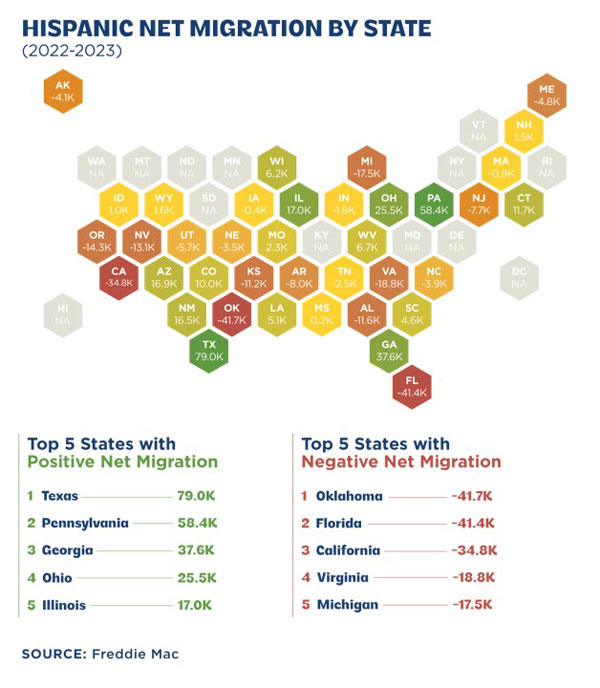
NAHREP
But even in areas considered relatively affordable, incomes are not
necessarily keeping pace, says the report, which features ample insights
from 25 local real estate practitioners scattered across the country.
“Again, it goes back to the affordability factor,” says Phillip Lopez in
Texas. “I mean, San Antonio still is a very affordable city, but it doesn’t
match up right now with the wages and what it is that a consumer is looking
for. If I’m only making $60,000 to $65,000 and I want to go buy a $300,000,
$350,000 home, it’s going to be pretty tough. You better have little to no
debt … So, if we’re talking about qualifying, a lot of them do still get
qualified. It’s just not what they were looking for because that price
difference of, you know, $60,000 to $100,000 from what it was in 2021 to
2023 – it is a big difference.”
Nevertheless, San Antonio makes it onto the report’s list of 25
“opportunity markets” based on affordability, a list that that also
includes eight other Texas metros:
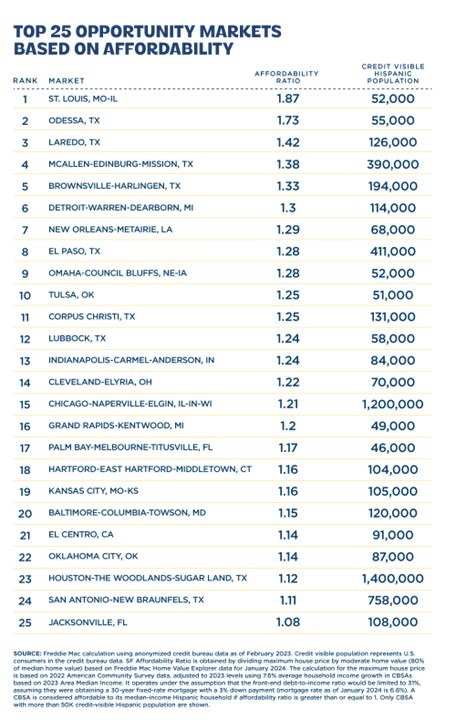
Demographically speaking, “with a median age of 30.7, Latinos are the
youngest racial or ethnic demographic in the U.S.,” the report states, more
than 10 years younger than the median age of non-Hispanics of any racial
background. Now more than two-thirds of Latinos are Millennials or younger.
-
“Latinos make up more than half of the under-18 population in New Mexico
(61.9%) and California (51.9%), and over 40% in Texas (49.1%), Arizona
(44.9%) and Nevada (41.7%),” said the report. “Latinos are widely
expected
to become the majority population in these states in the coming years.”
Among the data discoveries:
-
“Since 2012, the Hispanic population has increased in every single state
in the country by at least 8%. The five states that have experienced the
largest Hispanic population growth rates over the last decade are
Tennessee
(43.8%), Pennsylvania (42.9%), Idaho (41.5%), Rhode Island (38.6%), and
Maryland (38.3%).”
-
“For more than two decades, Latinos have held the highest labor force
participation rate of any racial or ethnic demographic, with a rate of
66.9% in 2023.” Latinas are now the second-largest group of female
workers
in the U.S., with a participation rate of 61.3% . Nearly one in five
workers in the labor force are Hispanic (19%, expected to grow to 21.9%
by
2032).
Courtesy of NAHREP Policy, Learning & Research Director Jaimie Smeraski,
the
lead author of the report, here are further employment and income-related
infographics from the report that point to indicators inherently factoring
into Hispanic homeownership:
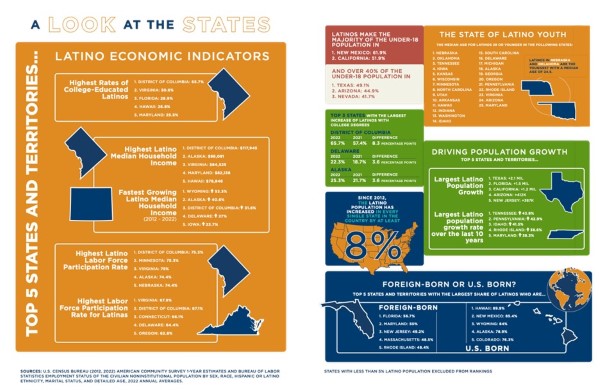
Rent Burden Report Brings the Data
The other report offering insights into workforce housing and its impact on
location decision-making is Rental Housing 2024, released in January
by the Harvard Joint Center for Housing Studies.
The headline finding: “In 2022, half of all U.S. renters were cost
burdened.
The number of renter households spending more than 30% of their income on
rent
and utilities rose by 2 million in just three years to a record high of
22.4
million.”
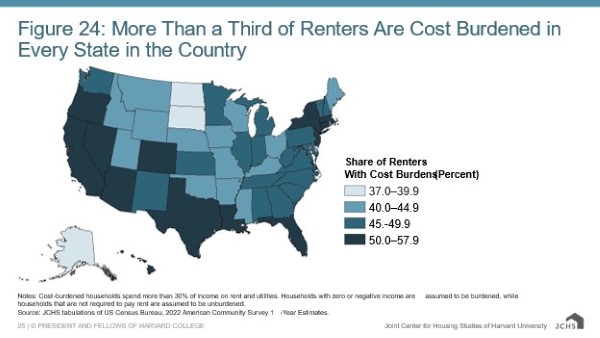
Even with the rent growth rate slowing substantially in Q3 2023, the report
said, asking rents rates are still well above pre-pandemic levels.
“Since 2019, cost-burden shares have risen the most for middle-income
renter
households earning between $30,000 and $74,999 annually,” a news release
explained. “Higher-income households also saw their burden rate increase by
2.2 percentage points. Even lower-income renters making less than $30,000
annually saw their cost-burden rate rise by 1.5 percentage points to 83%,
with
the majority (65%) experiencing severe burdens, marking yet another
all-time
high.”
Among other findings:
-
“Cost-burden shares are highest in the largest metros, where rents tend
to
be higher. More than half (51%) of renter households living in the 56
metros
with populations over 1 million were burdened by housing costs in 2022.”
-
“The loss of low-rent units has been geographically widespread. In more
expensive states already short on low-cost units, these losses extended
higher
up the rent spectrum, with 16 states losing units at all rent levels up
to
$1,400.”
-
“Nationwide, an estimated 75% of land in major cities is zoned
exclusively
for single-family homes. A growing list of states are preempting local
single-family zoning laws to compel more neighborhoods to allow a range
of
housing options.”
The Harvard Joint Center for Housing Studies offers a slew of reports
grounded
in robust data sets that the Center makes fully available along with a full
set of graphics and explainers. Those graphics include some that complement
and add new dimension to the NAHREP report on Hispanic homeownership,
including this one:
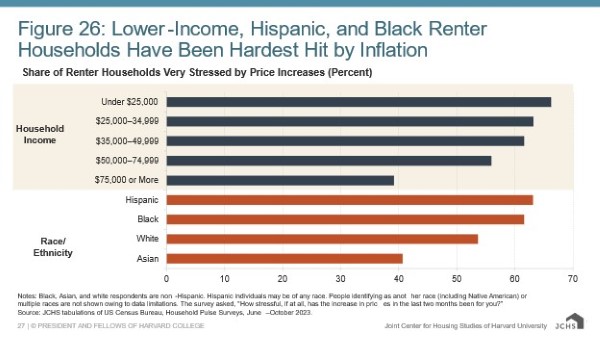
Significantly, the report was released at UnidosUS, the Washington,
D.C.-based
research, policy and advocacy organization whose home page reminds visitors
that more than 62 million Latinos live and work in the United States,
contributing $2.7 trillion to the economy.
The organization will hold its annual conference in Las Vegas in mid-July.
Alongside four other program tracks at the conference is one devoted to
workforce development. — Adam Bruns
|